1. Abraham Krohn
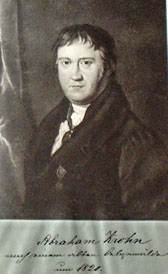
Abraham Krohn grew up in modest surroundings. His father, David Erdmann Krohn (between 1725 and 1735 - 1825), was a schoolmaster who taught him arithmetic and to read and write. As a young man, Abraham learnt the baker's craft and became a journeyman baker.
In 1785, Abraham moved to St Petersburg where his great uncle Johann Emmanuel Krohn (?-1825), who was a member of the Imperial Orchestra, lived. Johann obtained a job for the young Abraham in the Court bakery. Abraham soon became the Court baker and, every day, had to attend Empress Catherine II (1729-1796) in her palace taking a basket of bread.
In 1790, Abraham, probably with the assistance of Empress Catherine II (The Great), acquired enough resources to build a brewery on a piece of land in the Alexander Nevsky quarter beside the River Neva.
By 1793, when he married Alisabeth Balser (1770-1837), his brewery was already in production. But, a year after Catherine the Great's death in 1797, the whole brewery burnt down. The fire must have been a hard blow to Abraham, for, ultimately, he had to sell half of his land and on the remainder he built a new brewery. No doubt his enterprise prospered again, for when he visited Rügen (1818) he was described as very rich. Abraham's social position in St Petersburg had by that time improved. As was customary in Russia, the Municipal Authorities appointed him as a Merchant and Manufacturer and a Town Councillor.
In 1827 Abraham died suddenly from apoplexy and his wife Alisabeth Balser died after a short illness in 1837
For more information on Abraham Krohn and his descendants visit www.krohnfamily.org
2. Kristin Krohn Devold
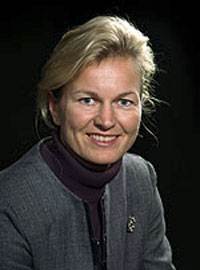
Kristin Krohn Devold is a Norwegian politician and is married with two children. She belongs to the Norwegian conservative party, Høyre. She was elected as a Member of the Norwegian Parliament (Stortinget), representing Oslo, from 1993 to 2005; She became the Norwegian Minister of Defense in 2001 and held the position until 2005. She was involved, as Defense Minister, in the war on terrorism and sent Norwegian soldiers to fight in Iraq and Afghanistan. In 2003, she was mentioned as a possible candidate for the position of Secretary General of NATO to replace The Right Honourable Lord Robertson of Port Ellen, but eventually lost out to Jaap de Hoop Scheffer.
Kristin is presently the CEO of a large Norwegian non-profit organization. See Norwegian Trekking Association administration information page
She holds a Master of Science Degree in Business from the Norwegian School of Economics and Business Administration (NHH), Bergen, 1985.
3. Dr. Friedrich Krohn
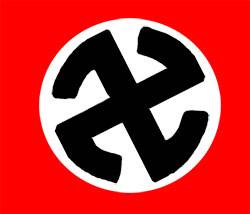
Not much is known about the life of Friedrich Krohn but we do know that he was a dentist in Starnberg, Germany and a member of the Thule Society. Most historians credit Friedrich Krohn as being the creator of the basic design of the swastika later used by Hitler and Nazi Germany. I have not been able to find a copy of Dr Krohn's original design but the image above is perhaps a close approximation to the original. His design was based on a destroverse or clockwise swastika with curved legs on a white background surrounded by red. Dr. Krohn presented this design to Hitler in 1919 or early 1920 and Hitler acknowledged his contribution in Mein Kampf:
"Actually, a dentist from Starnberg did deliver a design that was not bad after all, and, incidentally, was quite close to my own, having only the one fault that a swastika with curved legs was composed into a white disk."
Friedrich knew that the Buddhist or destroverse swastika symbolized good fortune and the majority of the Nazi leadership accepted Friedrich's design in 1920. However Hitler was adamant that a sinistroverse or anti-clockwise swastika become the symbol of Germany and Friedrich's design was reversed and the legs straightened.
4. Eric L. Krohn
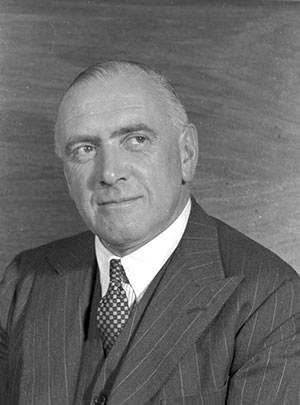
Eric Leslie Krohn, Cotton Merchant, 1890-1958
Eric was born in Newcastle-upon-Tyne, Northumberland on March 24th 1890. He was the first child of Wilhelm Krohn, who had immigrated from Lubeck Germany in the 1880s, and Wilhelm's wife,Caroline Swire, from Yorkshire. He moved to Liverpool in his early adulthood and joined H.W. Hooper & Co, a cotton importing company, as a saleman. In 1914, he married Doris Wade and a son, Peter, was born in January of 1916.During World War I, he served as a gunner in the Royal Garrison Artillery. After the war, the cotton trade flourished and Eric with a partner bought the cotton importing company. In the 1920s, Eric set up an american branch of H.W. Hooper & Co doing business under the name of Hooper & Day of Oklahoma. Unfortunately, this enterprise failed and, on April 8th 1938, the following appeared in the London Gazette:
NOTICE is hereby given that the Partnership heretofore subsisting between us the undersigned William Roberts and Eric Leslie Krohn carrying on business as Cotton Merchants at Liverpool in the county of Lancaster under the name or style of H. W. HOOPER & CO. and at Oklahoma in the United States of America under the name or style of HOOPER & DAY has been dissolved by mutual consent as from the 3ist day of March 1938 so far as concerns the said Eric Leslie Krohn and all debts due and owing to or by the said firm will be respectively received and paid by the said William Roberts, George Brooking Davey, George Rimmer and Leslie Roberts who as from the ist day of April 1938 will carry on the said business under the same names or styles.—As witness our hands this fourth day of April 1938.
During World War II, Eric served as an Auxiliary Constable with the British Police force and when the war was over he went back to the cotton trade. By now, the cotton trade in Liverpool was dying and Eric finally retired to his home in Hightown, just north of Liverpool. Eric enjoyed playing cricket and played for the Hightown club as Captain of both the first eleven and second eleven during the pre second world war years. Just before his death, his wife presented the Hightown Club with a donation to build a new scoreboard. Eric suffered a stroke in 1957 and after a few months in a nursing home died on February 3rd 1958.
5. Dr. Peter L. Krohn

Peter was born in Liverpool, England in 1916. He was educated at Sedbergh School and Balliol College, Oxford where he graduated with a honours degree in medicine. During World War II, Peter worked as a scientist with Solly Zuckerman (Later Baron Zuckerman of Burnham Thorpe) and among other projects worked on the effects of explosions on people. After the war Peter joined the Anatomy Department of the University of Birmingham where he became a Professor and did research in endocrinology. Peter was later elected as a Fellow of the Royal Society. The Royal Society said of his work:
Peter retired in his fifties to the island of Jersey and spent much of his later life in travel, trekking, photography and scuba diving. Peter died in his home in Jersey on May 25th 2009.P.L. Krohn has combined a wide experience of endocrinology, tissue transplantation, and of the immunological problems of the homograft reaction to bear on many important problems both in immunology and reproductive physiology. His study of the number of genetic loci controlling the transplantability of skin homografts in mice was the most thorough of its kind; by extending it to a simultaneous analysis of the genetic histocompatibility requirements of skin and ovary he has established the highly important fact that skin and ovary resemble each other with respect to approximately fifteen neutral marker genes. This discovery has an immediate and critical bearing on theories of genetic differentiation during development. Krohn is the first to undertake a systematic causal analysis of the ageing process by the technique of grafting tissues between animals of different ages, and he has put strain differences in the ageing of reproductive function in mice on to a quantitative basis. By appreciating the way in which immunologically tolerant mice can contribute to the analysis, and by his skill in developing techniques of orthotopic ovarian transplantation, he has thrown fresh light on the factors which control the rate of ageing of the ovary, and on the relative importance of environment and genetic make-up in the reproductive performance.
6. Juan Fernández Krohn
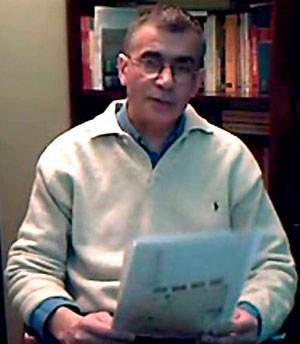
Juan María Fernández y Krohn was born in Spain in 1948. He is is a former Roman Catholic priest. On 12 May 1982, he tried to stab Pope John Paul II with a bayonet in Fátima, Portugal. It was unclear at the time whether he wounded the Pope or not, but recent accounts in the documentary "Testimony" reveal that the Pope was indeed cut by Krohn. Cardinal Stanislaw Dziwisz says in the movie:
I can now reveal that the Holy Father was wounded. When we got back to the room [in the Fatima sanctuary complex] there was blood
Krohn received a six year prison sentence for the attack on the Pope but was incarcerated for only three years before being expelled from Portugal. During his trial and afterwards in prison, he showed no remorse. Krohn remained opposed to the reforms of Vatican II and believed Pope John Paul II had been in league with the Soviet Union and was a secret Communist agent trying to corrupt the Vatican! Krohn abandoned the priesthood and after his release moved to Belgium where he became a controversial lawyer.
In Belgium he was accused of slapping judge and Cassation president Erik Carre in the face. Krohn was also accused of spreading anti-semitic propaganda in the councillors' room of the Brussels Palace of Justice.
In 1996, he was charged, although subsequently acquitted, with setting fire to Brussels headquarters of Basque separatist party Herri Batasuna, the political branch of the terrorist Basque separatist group ETA. Krohn was arrested again in July 2000 as he ran shouting accusations of murder toward the red carpet in front of the Royal Palace, where King Albert II and Queen Paola were awaiting the arrival of King Juan Carlos of Spain, who was making a state visit to Belgium. He accused King Juan Carlos of killing his brother Alfonso in order to become King of Spain. Krohn received a four-month probational sentence and a fine. After this arrest, Krohn has lived in Belgium and Spain and is reported to have become an expert in art and literature of the Spanish post Civil War period.
7. Kenneth Krohn
At a conference in 1962, Krohn and Rhodes announced that they had found a beautiful method to decompose any (deterministic) finite automaton into "simple" components (each itself a finite automaton). Their unexpected result was joint work and merited the award of two PhDs: Krohn was awarded a PhD from Harvard and Rhodes from MIT. The result was hailed as a major advance, for both theory and practice, and also had implications for philosophy. Many simpler versions of the theorem's proof have been published since their original paper.
Krohn and Rhodes set up the Krohn-Rhodes Research Institute at the University of California, Berkeley where they continued to work on the implications of their theorem.